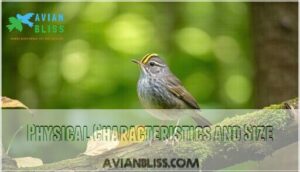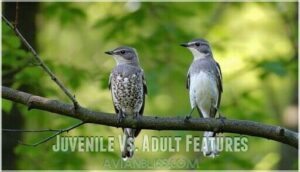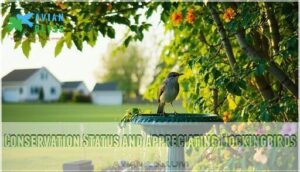This site is supported by our readers. We may earn a commission, at no cost to you, if you purchase through links.

You’ll recognize them by their slender build, long tail, and those distinctive white wing patches that flash during flight. But it’s their bold personality that truly sets them apart.
These birds don’t just inhabit yards and forest edges across North America—they claim them, dive-bombing cats and defending berry bushes with fierce determination that’s earned them both admiration and exasperation from those who share their territory.
Table Of Contents
- Key Takeaways
- Northern Mockingbird Identification and Appearance
- Habitat, Range, and Distribution
- Northern Mockingbird Behavior and Ecology
- Breeding, Nesting, and Life Cycle
- Conservation Status and Appreciating Mockingbirds
- Frequently Asked Questions (FAQs)
- What is special about Northern Mockingbird?
- What states have northern mockingbirds?
- How do you identify Northern Mockingbird?
- Where does the Northern Mockingbird usually live?
- What is the lifespan of a Northern Mockingbird?
- How many sounds can a Northern Mockingbird imitate?
- Are Northern Mockingbirds solitary or social birds?
- What predators do Northern Mockingbirds face?
- How do Northern Mockingbirds defend their territory?
- What do mockingbirds eat in winter months?
- Conclusion
Key Takeaways
- Northern mockingbirds are exceptional vocal mimics that can reproduce over 200 sounds—including other bird species, frogs, insects, and mechanical noises like car alarms—with males developing two distinct song repertoires and sometimes singing continuously for 24 hours during breeding season to attract mates.
- These medium-sized gray songbirds with distinctive white wing patches exhibit remarkably bold territorial behavior, aggressively defending their claimed spaces year-round by dive-bombing intruders ranging from hawks to house cats, making them one of nature’s most fearless songbirds.
- Originally southern birds, mockingbirds have steadily expanded their range throughout the 1900s to inhabit most of the continental United States, thriving in diverse habitats from urban parks to rural landscapes by adapting their diet seasonally between insects in warmer months and berries in winter.
- Despite protection under the Migratory Bird Treaty Act of 1918 ending commercial exploitation, populations declined 30% from 1966 to 2019 due to habitat loss and pesticide use, though targeted conservation efforts—including native plantings and reduced pesticide use—show promise for reversing these trends.
Northern Mockingbird Identification and Appearance
When you spot a Northern Mockingbird, you’ll notice it’s not a bird that hides in the shadows. This medium-sized songbird carries itself with confidence, whether perched on a utility wire or foraging across your lawn.
Here’s what to look for when identifying this bold mimic.
Physical Characteristics and Size
The Northern Mockingbird stands out as a medium-sized songbird with a slender frame, measuring 8.3 to 10.2 inches from bill to tail—roughly robin-sized but built for a different kind of life. Its long tail and proportionally small head are complemented by a thin beak with a subtle downward curve.
Its wingspan stretches 12.2 to 13.8 inches, while body weight ranges from 1.6 to 2.0 ounces—light enough for agile movement through open spaces.
Song and Mimicry Abilities
If the mockingbird’s appearance is understated, its voice more than compensates. This species is nature’s most adaptable impressionist, capable of mimicking dozens of other birds, frogs, insects, and even car alarms with startling accuracy.
Males develop two distinct song repertoires through vocal learning, repeating imitation techniques in non-random patterns. Both sexes sing, though males vocalize more actively.
Unpaired males perform 24-hour singing marathons during breeding season, their mimicry skills serving as elaborate bird communication to attract potential mates.
During breeding season, unpaired male mockingbirds sing around the clock, using their impressive mimicry to attract mates
Juvenile Vs. Adult Features
Young mockingbirds wear spotted chests and lack the clean gray-and-white palette that makes adults so recognizable. These juvenile markings fade as feather color transitions during plumage development stages. You’ll notice their beak shape remains similar, though overall proportions shift with maturity.
Understanding these maturity stages helps with bird identification when observing nesting behavior—juveniles usually complete their transformation within months of fledging, gradually adopting the sleek avian biology characteristics that define adult Northern Mockingbirds.
Gender Differences
Male and female mockingbirds look nearly identical, but you can spot the difference when they open their beaks to sing. Males vocalize more frequently, especially unpaired ones during breeding season, who sing around the clock to attract mates. Here’s how Sex Roles and Courtship Displays differ:
- Males produce louder, more persistent songs year-round
- Females sing less often and more quietly
- Both sexes defend territories in a monogamous mating relationship
Despite minimal Plumage Variations or Gender Size differences, Mating Habits reveal distinct behavioral patterns in Northern mockingbird pairs.
Habitat, Range, and Distribution
You’ll find northern mockingbirds across most of the continental United States, stretching into southern Canada and down through Mexico. These adaptable songbirds have claimed territories from coast to coast, thriving in forest edges, open woodlands, and surprisingly urban landscapes.
Let’s explore where these vocal mimics make their homes and how they’ve expanded their range over the past century.
Geographic Range in North America
Originally a southern species, the Northern Mockingbird steadily expanded its range throughout the 1900s, marching northward along both coasts until it claimed territory across most of the continental United States, southern Canada, and Mexico.
Today, you’ll find them nearly everywhere from coast to coast, with populations thriving in the Greater Antilles, Bahamas, and Cayman Islands. Range extension has transformed this once-regional bird into a continental success story.
Preferred Habitats and Environment
Forest edges and open ground are where this bird truly thrives—you’ll spot them claiming perches in parks, suburban yards, and anywhere that offers a mix of scattered trees and open foraging space.
Northern Mockingbird habitat includes forest edges and garden habitats where they select specific trees like sycamore, maple, and sweetgum while avoiding pines. These ecological habitats support their foraging needs perfectly, and urban landscapes with streetlights and telephone poles create ideal suburban ecosystems for these adaptable birds.
Urban, Suburban, and Rural Adaptation
Whether you’re strolling through a city park or scanning the fenceposts along a gravel road, you’ll find mockingbirds have mastered the art of making themselves at home in practically any landscape humans create. Their adaptive strategies include exploiting suburban gardens, thriving in urban planning designs with streetlights, and dominating rural landscapes.
This flexibility in habitat choice demonstrates exceptional bird behavior and ecology, making human interaction with Northern Mockingbirds increasingly common across wildlife conservation areas.
Migration Patterns and Seasonal Movements
Unlike many songbirds, Northern Mockingbirds aren’t committed long-distance travelers. You’ll notice that most populations stay put year-round, relying on their striking adaptability rather than seasonal routes to survive changing conditions.
Migration habits vary by latitude:
- Northernmost populations may migrate south during harsh winter weather, while southern birds remain sedentary
- Range extension continues northward as mockingbirds colonize new territories with milder climates
- Weather effects and food availability drive localized movements rather than predictable migration timing
These altitude changes and geographic dispersion patterns distinguish Northern Mockingbird migration patterns from typical songbird migration patterns. The Northern Mockingbird’s diet and feeding habits also play a vital role in their ability to thrive in various environments.
Northern Mockingbird Behavior and Ecology
Northern Mockingbirds aren’t just talented mimics—they’re bold, resourceful birds with fascinating daily routines. From fiercely defending their turf to foraging with surprising tactics, their behavior reveals a species perfectly adapted to life alongside humans.
Let’s explore how these birds interact with their world through three key aspects of their ecology.
Bold Personality and Territorial Defense
Northern mockingbirds don’t just defend their territory—they patrol it like feathered sentries, ready to dive-bomb anything from hawks to house cats that dares cross their invisible property lines. During breeding season, males intensify their territorial behavior, using song patterns as defensive strategies to warn rivals. You’ll witness aggressive behavior peak from March through August, when border disputes erupt between neighboring males.
| Territorial Marking | Defensive Strategies | Mockingbird Behavior |
|---|---|---|
| Singing from high perches | Dive-bombing intruders | Chasing competitors |
| Patrolling boundaries | Wing-flashing displays | Physical confrontations |
| Repeated call sequences | Persistent pursuit | Year-round vigilance |
This defending territory instinct makes the Northern Mockingbird one of nature’s boldest songbirds.
Foraging Tactics and Diet Composition
You’d be surprised how much strategy goes into a mockingbird’s hunt—these birds switch between ground patrol and aerial ambush depending on what’s crawling, flying, or ripening nearby.
Their foraging strategies adapt seasonally: insect capture dominates spring and summer feeding behavior when beetles and grasshoppers are abundant, while berry consumption and seed gathering sustain them through fall and winter.
This flexible avian diet—including mulberries, blackberries, caterpillars, and spiders—lets mockingbirds thrive across diverse food sources year-round.
Social Behavior and Communication
When food’s plentiful, mockingbirds turn their attention to something just as essential—defending territory and broadcasting status through some of the most complex vocalizations in North America. Their territorial songs and mimicry serve dual purposes: establishing social bonds within pairs while warning rivals away.
Males sing tirelessly during breeding season for mate attraction, sometimes performing 24-hour vocal marathons. This vocal learning ability creates unique communication styles that vary by individual and region.
Breeding, Nesting, and Life Cycle
Northern Mockingbirds follow a fascinating reproductive cycle that spans from territory establishment through fledgling independence. The breeding season brings dramatic changes in behavior as these birds prepare for raising their young.
Here’s what you need to know about their nesting habits, from nest building through the development of their offspring.
Nest Placement and Construction
In the sheltered fork of a shrub or low tree, mockingbirds craft their cup-shaped nests with impressive resourcefulness, weaving together twigs, grasses, and even scraps of string or paper. You’ll find these cup nests usually 3-10 feet above ground, where dense foliage offers cover from predators.
Both sexes participate in nest building, with the female managing most of the intricate weaving while the male brings materials to the nest site.
Egg Laying, Incubation, and Hatching
Once the nest is complete, the female lays 3-4 eggs—occasionally as few as 2 or as many as 6—each one displaying a soft greenish to bluish-gray tint with brown speckles clustered toward the larger end. She alone manages the incubation period of 12-13 days, maintaining ideal egg formation conditions.
The hatching process unfolds predictably:
- Eggs crack after nearly two weeks of warmth
- Nestlings emerge helpless and naked
- Nesting success depends on shelter and parental vigilance
This Northern Mockingbird characteristic ensures fledgling care begins promptly.
Parental Care and Fledgling Development
Both parents shoulder the feeding duties the moment the nestlings hatch, delivering insects and berries throughout daylight hours until the young leave the nest around 12 days later. Nestling growth accelerates rapidly during this parental feeding phase.
Even after the fledgling stage begins, chick development continues for another week as the young Northern Mockingbird perfects flight skills while still relying on adults for food—a critical bird watching tip for observers tracking brood size across 2-3 nesting cycles annually.
Mating Systems and Monogamy
Fidelity runs deep in Northern Mockingbird pair bonds, with many mates staying together across multiple breeding seasons once courtship succeeds. Monogamous relationships form after males perform elaborate courtship displays—often singing relentlessly to attract a mate.
You’ll notice breeding strategies emphasize pair bonding strength over seasonal mate selection, though some individuals do switch partners. This mating system facilitates the species’ breeding habits of raising 2-3 broods annually with coordinated parental investment.
Conservation Status and Appreciating Mockingbirds
The northern mockingbird has weathered both hardship and triumph over the past two centuries. Understanding its conservation journey helps you appreciate these resilient birds and support their continued success.
Here’s what you need to know about protecting mockingbirds and welcoming them into your world.
Historical Decline and Recovery
Northern Mockingbird populations tell a story of resilience. The Migratory Bird Treaty Act of 1918 ended commercial hunting and feather trade exploitation that had devastated their numbers. Despite this species protection, breeding bird surveys documented a concerning 30% population decline from 1966 to 2019 across North America.
Habitat loss, pesticide use, and reduced insect availability drove these declines. Yet recovery strategies show promise—Ontario breeding sites doubled between the 1980s and early 2000s, demonstrating that targeted wildlife conservation efforts and ecological habitat preservation can reverse negative population trends.
Conservation efforts focus on understanding bird migration patterns to better protect the species.
Current Conservation Efforts and Threats
Today, Wildlife Protection agencies monitor Northern Mockingbird population trends through standardized breeding bird surveys. Climate Change poses emerging threats—shifting insect phenology disrupts feeding schedules, while extreme weather events destroy nesting sites.
Human Impact remains significant: window collisions, pesticide exposure, and Habitat Preservation challenges in developing regions affect their Conservation Status.
Wildlife Conservation Efforts now emphasize native berry plantings and pesticide reduction. Ecological Habitat Preservation paired with adaptive Conservation Strategies offers your best hope for maintaining stable populations across their range.
How to Attract Mockingbirds to Your Yard
You can transform your yard into a mockingbird haven by planting native fruit-bearing shrubs and creating open foraging spaces that mirror their natural habitat. Consider these Garden Maintenance Strategies for Attracting Northern Mockingbirds:
- Install Water Feature Installation elements like birdbaths for drinking and bathing—they’ll visit daily during warm months
- Choose Bird Friendly Plants and Native Plants for Birds including mulberry, blackberry brambles, and sweetgum for Food Source Variety
- Design Yard Layout Tips with open lawns bordered by shrubs—perfect for ground foraging while bird watching
This approach fosters Northern Mockingbird populations naturally.
Northern Mockingbird as a State Symbol
The northern mockingbird holds official honors across five states—Florida, Tennessee, Mississippi, Arkansas, and Texas—earning its place as the third most popular state bird in America. Only the northern cardinal and western meadowlark rank higher in state bird designations. This national recognition reflects the mockingbird’s cultural significance and widespread appeal throughout the South, where Mimus polyglottos thrives in diverse habitats.
| State | Year Designated |
|---|---|
| Arkansas | 1929 |
| Florida | 1927 |
| Mississippi | 1944 |
| Tennessee | 1933 |
| Texas | 1927 |
The symbolic meaning centers on the species’ bold personality and musical range, traits valued across these regions.
Frequently Asked Questions (FAQs)
What is special about Northern Mockingbird?
Mimicry stands out as this species’ most striking trait. Northern Mockingbirds can imitate over 200 sounds—from other birds to car alarms—creating complex songs that showcase their intelligence and vocal range.
Their adaptation abilities and unique plumage make identification straightforward.
What states have northern mockingbirds?
Across most of the continental United States, you’ll find Northern Mockingbirds thriving—from coast to coast, with populations stretching into southern Canada and Mexico.
This geographic range includes their designation as state bird in Florida, Texas, Tennessee, Mississippi, and Arkansas.
How do you identify Northern Mockingbird?
Look for gray plumage with white wing patches and a black eye mask. Song recognition helps—these birds mimic other species.
Check beak shape, tail length, and feather patterns for accurate identification.
Where does the Northern Mockingbird usually live?
Mockingbirds thrive in forest edges, suburban areas, urban habitats, and rural landscapes across their geographic range.
These adaptable birds favor open spaces with scattered trees, shrubs, and streetlights—ecological habitats that support their foraging and territorial behaviors year-round.
What is the lifespan of a Northern Mockingbird?
Average Longevity in wild populations reaches eight years, though Survival Tactics and habitat quality influence Mortality Rates markedly.
Ornithology Research documents individuals exceeding ten years under favorable conditions. Aging Process and predation remain primary Lifespan Factors affecting this species.
How many sounds can a Northern Mockingbird imitate?
Like a digital jukebox of the natural world, males can learn and perform over 200 distinct song types—imitating bird calls, animal sounds, and even mechanical noises like car alarms through their exceptional vocal imitation abilities.
Are Northern Mockingbirds solitary or social birds?
During breeding season, Northern Mockingbirds are fiercely solitary and territorial. Males defend their space aggressively.
Outside nesting periods, you’ll sometimes spot them in loose groups, though they usually forage and live alone year-round.
What predators do Northern Mockingbirds face?
Hawks, snakes, and domestic cats pose the greatest threats to Northern Mockingbirds. Nest predators, including crows, jays, and raccoons, target eggs and nestlings.
Adults use aggressive territorial defense and alarm calls for predator avoidance.
How do Northern Mockingbirds defend their territory?
Aggressive displays—wing flashing, dive-bombing intruders, and even attacking their own reflections in hubcaps—mark Northern Mockingbird territorial behavior.
Males patrol territory borders relentlessly, using song battles and physical confrontations to defend nesting areas from rivals and predators alike.
What do mockingbirds eat in winter months?
During winter, mockingbirds shift from insect-heavy diets to berries and wild fruits. Berry feeding becomes essential when insect scarcity increases.
They consume mulberries, blackberries, and other fruits, supplementing with seeds and any available insects.
Conclusion
From backyard sentry to midnight soloist, the northern mockingbird transforms ordinary spaces into stages for remarkable performances. You’ve learned to spot those white wing flashes, decode territorial dive-bombs, and recognize the dawn concerts that announce breeding season.
Whether they’re defending berry-laden shrubs or mimicking your neighbor’s car alarm at 3 AM, these gray virtuosos remind us that wildness thrives wherever determination meets opportunity—and that nature’s most memorable characters rarely ask permission before making themselves at home.
- https://macaulaylibrary.org/photo/42324121
- https://www.coxcastle.com/publication-is-it-a-crime-to-kill-a-mockingbird-federal-court-weighs-in-on-the-migratory-bird-treaty-act-1
- https://www.allaboutbirds.org/guide/Northern_Mockingbird/lifehistory
- https://digitalcommons.usf.edu/cgi/viewcontent.cgi?article=2182&context=ffn
- https://naturecounts.ca/nc/socb-epoc/species.jsp?sp=normoc











